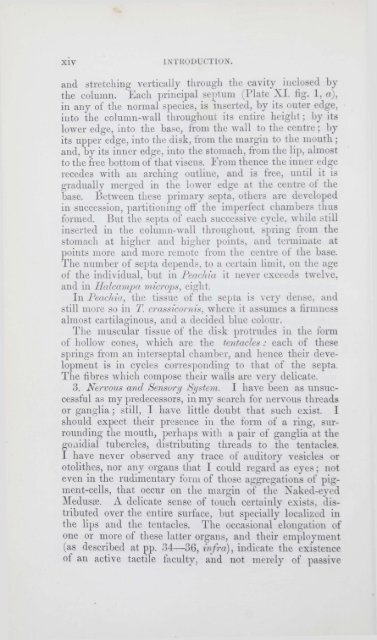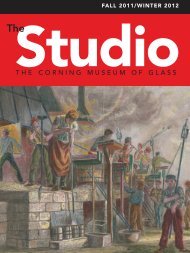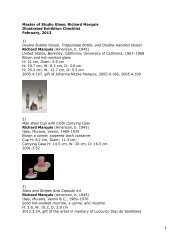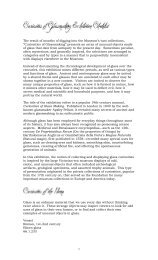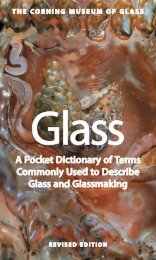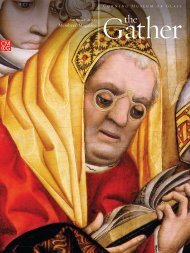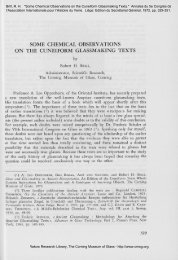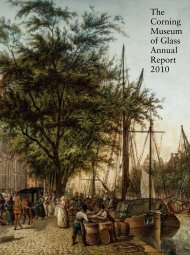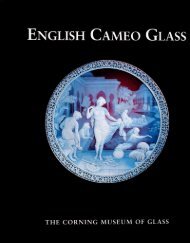- Page 2: The Juliette K. and Leonard S. Rako
- Page 9: A C T I N O L O G I A B R I T A N N
- Page 12 and 13: vi PREFACE. by Dr. Johnston has hit
- Page 14 and 15: viii PREFACE. My labour has been pe
- Page 16 and 17: X LIST OF PLATES. X.—1. Lophoheli
- Page 18 and 19: xii INTRODUCTION. 1. Tegumentary Sy
- Page 22 and 23: xvi INTRODUCTION. touched with inst
- Page 24 and 25: xviii INTRODUCTION. averaging '0005
- Page 26 and 27: XX INTRODUCTION. That the function
- Page 28 and 29: xxii INTRODUCTION. separate, and in
- Page 30 and 31: xxiv INTRODUCTION. what irregular i
- Page 32 and 33: xxvi INTRODUCTION. eye, supposing t
- Page 34 and 35: xxviii INTRODUCTION. power of the m
- Page 36 and 37: XXX INTRODUCTION. its inner surface
- Page 38 and 39: xxxii INTRODUCTION. error of anothe
- Page 40 and 41: xxxiv INTRODUCTION. until after man
- Page 42 and 43: xxxvi INTRODUCTION. lining membrane
- Page 44 and 45: xxxviii INTRODUCTION. presented to
- Page 46 and 47: xl INTRODUCTION. though, in order t
- Page 48 and 49: 2 GENERAL DESCRIPTION 2. THE COLUMN
- Page 50 and 51: 4 GENERAL DESCRIPTION which is next
- Page 52 and 53: 6 CLASS ZOOPHYTA. ANIMALS of radiat
- Page 54 and 55: 8 FAMILY I.—METRIDIADÆ. The memb
- Page 56 and 57: 10 ANALYSIS OF THE GENERA.* Tentacl
- Page 58 and 59: ASTRÆACEA. THE PLUMOSE ANEMONE. Ac
- Page 61 and 62: THE PLUMOSE ANEMONE. 13 COLOUR. Col
- Page 63 and 64: THE PLUMOSE ANEMONE. 15 Müller has
- Page 65 and 66: THE PLUMOSE ANEMONE. 17 many of the
- Page 67 and 68: THE PLUMOSE ANEMONE. 19 There are p
- Page 69 and 70: THE PLUMOSE ANEMONE. 21 intersepts,
- Page 71 and 72:
THE PLUMOSE ANEMONE. 23 from its dr
- Page 73 and 74:
25 GENUS II. SAGARTIA (GOSSE). Acti
- Page 75 and 76:
ASTRÆ ACE A. SAG ARTIADÆ THE DAIS
- Page 77 and 78:
THE DAISY ANEMONE. 29 SIZE. The ave
- Page 79 and 80:
THE DAISY ANEMONE. 31 marked, and a
- Page 81 and 82:
THE DAISY ANEMONE. 33 narrow shallo
- Page 83 and 84:
THE DAISY ANEMONE. 35 extreme diame
- Page 85 and 86:
THE DAISY ANEMONE. 37 case it will
- Page 87 and 88:
THE DAISY ANEMONE. in some measure
- Page 89 and 90:
ASTRÆACEA. SAGARTIADÆ. THE SCARLE
- Page 91:
P. H,C DEL. 1. 8. SAGARTIA NIVEA .
- Page 94 and 95:
44 SAGARTIADÆ.. investigation only
- Page 96 and 97:
46 SAGARTIADÆ. the wall of the sto
- Page 98 and 99:
ASTRÆACE A. SAGARTIADÆ. THE ROSY
- Page 100 and 101:
50 SAGARTIADÆ. There is no doubt t
- Page 102 and 103:
52 SAGARTIADÆ. palmata that spring
- Page 104 and 105:
ASTRÆ ACE A. THE ORNATE ANEMONE. S
- Page 106 and 107:
56 SAGARTIADÆ. with that of any of
- Page 108 and 109:
58 SAGARTIADÆ. LOCALITY. The south
- Page 110 and 111:
ASTRÆACEA. SAGARTIADÆ. THE ORANGE
- Page 112 and 113:
62 SAGARTIADÆ. troglodyte habit, i
- Page 114 and 115:
64 SAGARTIADÆ. I think it more tha
- Page 116 and 117:
66 SAGARTIADÆ. detached from the b
- Page 118 and 119:
68 SAGARTIADÆ. SIZE. Large specime
- Page 120 and 121:
70 SAGARTIADÆ. I scrambled across,
- Page 122 and 123:
72 SAGARTIADÆ. already mentioned i
- Page 124 and 125:
74 SAGARTIADÆ. which is occasional
- Page 126 and 127:
76 SAGARTIADÆ. least rendered it h
- Page 128 and 129:
ASTRÆACEA. SAGARTIADÆ. THE PALLID
- Page 130 and 131:
80 SAGAKTIADÆ. that they were hut
- Page 132 and 133:
ASTRÆACEA. SAGARTIADÆ. THE TRANSL
- Page 134 and 135:
ASTRÆACEA. SAGARTIADÆ. THE EYED A
- Page 136 and 137:
86 SAGARTIADÆ. and sea-weeds;" but
- Page 138 and 139:
ASTRÆACEA. SAGARTIADÆ. THE CAVE-D
- Page 140 and 141:
90 SAGARTIADÆ. LOCALITY. The coast
- Page 142 and 143:
92 SAGARTIADÆ. this in Protean var
- Page 144 and 145:
94 SAGARTIADÆ. sometimes three or
- Page 146 and 147:
96 SAGAETIADÆ. organs; sometimes b
- Page 148 and 149:
98 SAGARTIADÆ. the tentacles, espe
- Page 150 and 151:
100 SAGARTIADÆ.. With a pipette I
- Page 152 and 153:
102 SAGARTIADÆ. to select and abri
- Page 154 and 155:
104 SAGARTIADÆ. ments may be remov
- Page 156 and 157:
106 SAGARTIADÆ. COLOUR. Column. Gr
- Page 159 and 160:
THE SNAKE-LOCKED ANEMONE. 107 and i
- Page 161 and 162:
THE SNAKE-LOCKED ANEMONE. 109 abjec
- Page 163 and 164:
THE SNAKE-LOCKED ANEMONE. 111 the m
- Page 165 and 166:
THE PARASITIC ANEMONE. 113 differen
- Page 167 and 168:
THE PARASITIC ANEMONE. 115 on some
- Page 169 and 170:
THE PARASITIC ANEMONE. 117 never fo
- Page 171 and 172:
ASTRÆACEA. SAGARTIADÆ. THE GOLD-S
- Page 173 and 174:
THE GOLD-SPANGLED ANEMONE. 121 was
- Page 175 and 176:
SAGARTIADÆ. 123 and to continue de
- Page 177 and 178:
ASTRÆACEA. SAGARTIADÆ. THE CLOAK
- Page 179 and 180:
THE CLOAK ANEMONE. 127 pointed out
- Page 181 and 182:
THE CLOAK ANEMONE. 129 writing this
- Page 183 and 184:
THE CLOAK ANEMONE. 131 membrane is
- Page 185 and 186:
THE CLOAK ANEMONE. 133 P. H. G.: Fa
- Page 187 and 188:
ASTRÆACEA. SAGARTIADÆ. THE WALLED
- Page 189 and 190:
THE WALLED CORKLET. 137 It has been
- Page 191 and 192:
THE WALLED CORKLET. 139 gular, clea
- Page 193 and 194:
THE WARTED CORKLET. 141 By a curiou
- Page 195 and 196:
ASTRÆACEA. SAGARTIADÆ. THE PAINTE
- Page 197 and 198:
145 GENUS V. GREGORIA (GOSSE). Base
- Page 199 and 200:
THE EYELET. 147 which is highly int
- Page 201 and 202:
ANTHEADÆ. 149 to be peculiar, and
- Page 203 and 204:
151 GENUS I. AIPTASIA (GOSSE). Anth
- Page 205 and 206:
THE TRUMPLET. 153 Acontia. Abundant
- Page 207 and 208:
THE TRUMPLET. 155 favoured me, I pe
- Page 209 and 210:
THE TRUMPLET. 157 fig, the lower ha
- Page 211 and 212:
159 GENUS II. ANTHEA (JOHNSTON). Ac
- Page 213 and 214:
THE OPELET. 161 Tentacles. About on
- Page 215 and 216:
THE OPELET. 163 This is the species
- Page 217 and 218:
THE OPELET. 165 by their own weight
- Page 219 and 220:
THE OPELET. 167 they had fallen, cl
- Page 221 and 222:
THE OPELET. 169 and now the Bullhea
- Page 223 and 224:
171 FAMILY IV.—ACTINIADÆ. The sp
- Page 225 and 226:
ACTINIADÆ. 173 with the beautiful
- Page 227 and 228:
ASTRÆACEA. ACTINIADÆ. THE BEADLET
- Page 229 and 230:
THE BEADLET. 177 hue exists alone,
- Page 231 and 232:
THE BEADLET. 179 never found it ass
- Page 233 and 234:
THE BEADLET. 181 by no means unusua
- Page 235 and 236:
183 FAMILY V.— BUNODIDÆ. I propo
- Page 237 and 238:
185 GENUS I. BOLOCERA (GOSSE). Anth
- Page 239 and 240:
THE DEEPLET. 187 SIZE. Three or fou
- Page 241 and 242:
189 GENUS II. BUNODES (GOSSE). Acti
- Page 243:
P. H G . DEl. 1. TEALIA CRASSICORNI
- Page 246 and 247:
192 BUNODIDÆ. LOCALITY. The south-
- Page 248 and 249:
194 BUNODIDÆ. The voracity of the
- Page 250 and 251:
196 BUNODIDÆ. the yellow mark is b
- Page 252 and 253:
ASTRÆACEA. BUNODIDÆ. THE RED-SPEC
- Page 254 and 255:
200 BUNODIDÆ. species, in his admi
- Page 256 and 257:
ASTRÆACEA. BUNODIDÆ. THE DIADEM P
- Page 258 and 259:
204 BUNODIDÆ. It is manifest that
- Page 260 and 261:
ASTUÆACEA. DUNODIDÆ. THE MARIGOLD
- Page 263 and 264:
THE MARIGOLD WARTLET. 207 SIZE. Col
- Page 265 and 266:
ASTRÆACEA. BUNODIDÆ. THE DAHLIA W
- Page 267 and 268:
THE DAHLIA WARTLET. 211 SIZE. Diame
- Page 269 and 270:
THE DAHLIA WARTLET. 213 panded, des
- Page 271 and 272:
THE DAHLIA WARTLET. 215 Shore-crab
- Page 273 and 274:
THE DAHLIA WARTLET. 217 crassicorni
- Page 275 and 276:
ASTRÆACEA. BUNODIDÆ. THE NECKLET.
- Page 277 and 278:
221 GENUS V. STOMPHIA (GOSSE). Base
- Page 279 and 280:
THE GAPELET. 223 Disk. White or yel
- Page 281 and 282:
THE GAPELET. 225 The Gapelet is rat
- Page 283 and 284:
227 FAMILY VI.—ILYANTHIDÆ. When
- Page 285:
P. H.C DEL 1 . PHELLIA GAUSAPATA .
- Page 288 and 289:
ASTRÆACEA. ILYANTHIDÆ. THE SCOTTI
- Page 290 and 291:
ASTRÆACEA. ILYANTHIDÆ. THE SCARLE
- Page 292 and 293:
234 GENUS II. PEACHIA (GOSSE). Siph
- Page 295 and 296:
ASTRÆACEA. ILYANTHIDÆ. THE ARROW
- Page 297 and 298:
THE ARROW MUZZLET. 237 The heavy ea
- Page 299 and 300:
ASTRÆACEA. ILYANTHIDÆ. THE WAVED
- Page 301 and 302:
THE WAVED MUZZLET. 241 into sea-wat
- Page 303 and 304:
ASTRÆACEA. ILYANTHIDÆ. THE TREFOI
- Page 305 and 306:
THE TREFOIL MUZZLET. 245 a number o
- Page 307 and 308:
ASTRÆACEA. ILYANTHIDÆ. THE SAND P
- Page 309 and 310:
THE SAND PINTLET. 249 specific appe
- Page 311 and 312:
THE SAND PINTLET. 251 to form an ov
- Page 313 and 314:
THE HOCK PINTLET. 253 I found this
- Page 315 and 316:
ASTRÆACEA. ILYANTHIDÆ. THE PAINTE
- Page 317 and 318:
THE PAINTED PUFFLET. 257 the habit
- Page 319 and 320:
ASTRÆACEA. ILYANTEIDÆ. THE CRIMSO
- Page 321 and 322:
THE CRIMSON PUFFLET. 261 dwells, cl
- Page 323 and 324:
263 GENUS V. ARACHNACTIS (SARS). Co
- Page 325 and 326:
THE SPRAWLET. 265 SIZE. Length of c
- Page 327 and 328:
267 GENUS VI. CERIANTHUS (DELLA CHI
- Page 329 and 330:
THE VESTLET. 269 Mouth. A transvers
- Page 331 and 332:
THE VESTLET. 271 The animal is hard
- Page 333 and 334:
THE VESTLET. 273 Mr. E. Edwards, of
- Page 335 and 336:
THE VESTLET. 275 tentacles "02/24,"
- Page 337 and 338:
277 ANALYSIS OF THE BRITISH FAMILIE
- Page 339 and 340:
279 GENUS I. CAPNEA (FORBES). Base
- Page 341 and 342:
THE CROCK. 281 LOCALITY. Deep water
- Page 343:
1. 5. CORYNACTIS VIRIDIS 6 . BOLOCE
- Page 346 and 347:
284 CAPNEADÆ. In August, 1856, the
- Page 348 and 349:
286 CAPNEADÆ. Mouth. Slit-like, co
- Page 350 and 351:
288 GENUS III. CORYNACTIS (ALLMAN).
- Page 352 and 353:
290 CAPNEADÆ. rounded by a thick l
- Page 354 and 355:
292 CAPNEADÆ. The expanded disk, w
- Page 356 and 357:
294 CAPNEADÆ. The cnidæ in this s
- Page 358 and 359:
296 GENUS I. ZOANTHUS (CUVIER). Bas
- Page 360 and 361:
298 ZOANTHDÆ. Tentacles. Twenty-ei
- Page 362 and 363:
300 ZOANTHIDÆ. In this condition,
- Page 364 and 365:
302 ZOANTHIDÆ. morsel be laid gent
- Page 366 and 367:
304 ZOANTHIDÆ. SIZE. Column about
- Page 368 and 369:
306 ZOANTHIDÆ. at a very low sprin
- Page 370 and 371:
308 ANALYSIS OF BRITISH GENERA. Wit
- Page 373 and 374:
309 GENUS I. CARYOPHYLLIA (LAMARCK)
- Page 375 and 376:
THE DEVONSHIRE CUP-COEAL. 311 are w
- Page 377 and 378:
THE DEVONSHIRE CUP-CORAL. 313 centr
- Page 379 and 380:
THE DEVONSHIRE CUP-CORAL. 315 say,
- Page 381 and 382:
CARYOPHYLLIACEA. THE MORAY CUP-CORA
- Page 383 and 384:
CARYOPHYLLIACEA. TURBINOLIADÆ. THE
- Page 385 and 386:
CARYOPHYLLIACEA. THE WINGED CUP-COR
- Page 387 and 388:
323 GENUS III. SPHENOTROCHUS (M. ED
- Page 389 and 390:
THE SMOOTH-RIBBED WEDGE-CORAL. 325
- Page 391 and 392:
THE KNOTTED WEDGE-COPAL. 327 just w
- Page 393 and 394:
329 GENUS IV. ULOCYATHUS (SARS). Fl
- Page 395 and 396:
THE SCARLET CRISP-CORAL. 331 covere
- Page 397 and 398:
333 GENUS I. LOPHOHELIA (M. EDW. &
- Page 399 and 400:
THE TUFT-CORAL. 335 age: the specim
- Page 401 and 402:
GENUS I. HOPLANGIA (GOSSE). Phyllan
- Page 403 and 404:
THE WEYMOUTH CARPET-CORAL. 339 Colu
- Page 405 and 406:
341 FAMILY VI.—EUPSAMMIADÆ. The
- Page 407 and 408:
CARYOPHYLLIACEA. EUPSAMMIADÆ. THE
- Page 409 and 410:
THE SCARLET AND GOLD STAR-CORAL. 34
- Page 411 and 412:
THE SCARLET AND GOLD STAR-CORAL. 34
- Page 413:
P. H GOSS . DEL ANATOMICAL DETAILS
- Page 416 and 417:
350 APPENDIX. COLOUR. Column. Expos
- Page 418 and 419:
352 APPENDIX. a ring a little deepe
- Page 420 and 421:
354 APPENDIX. 11. SPECIES DESCRIBED
- Page 422:
356 APPENDIX. IV. GEOGRAPHIC AL DIS
- Page 425:
1. PHELLIA PICTA 2. ZOANTHUS SULCAT
- Page 428 and 429:
360 INDEX. Cnidæ, xx. xxvii. Cuid
- Page 430 and 431:
362 INDEX. Tentacles, 3. elongation
- Page 432 and 433:
8 TRIBE I.—ASTRÆACEA. All the me
- Page 434:
10 ANALYSIS OF THE GENERA. Tentacle


